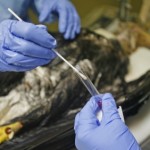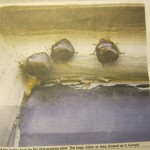I just looked at the World Health Organization's (WHO) most recent statistics on human cases of avian influenza H5N1, the dreaded bird flu. These cover the period from 2003 through March 10, 2012 and report 596 total cases and 350 deaths. The counties with the great numbers of cases are Indonesia, Egypt and Vietnam and I didn't see any reports of bird flu infections in the Western Hemisphere...yet.
That's a relatively tiny number of cases, but an incredibly high percentage of deaths, nearly 60% of those infected. But influenza epidemics and pandemics have been a common occurrence in the last century. So what's the difference between our seasonal flu, the pandemics and this new flu?
The Food and Agriculture Organization of WHO has published the first three chapters (of nine) of an online primer on avian influenza. It seemed a good place for me to start.
The first issue is how easily a new flu virus passes from animals to humans (the usual hosts are birds, typically ducks and, secondarily, chickens, especially if flocks are raised in proximity to each other and the ducks are "free range") and then from one person to another. The second is how deadly the particular influenza virus is.
Up until now those infected with the relatively new H5N1 subtype, sometimes called H5N1 HPAI, have had direct or at least indirect contact with infected birds. The HPAI is the acronym for "Highly Pathogenic Avian Influenza," but in this case highly pathogenic, which translates into very likely to cause disease, mostly refers to birds. Unlike seasonal flu, there's been (thus far) absolutely no documented human-to-human spread of the virus.
The 1918 Spanish flu infected 1/3 of everyone alive and killed at least 20 million. My math says that's roughly 4%, but 3% is the usual quoted figure. Seasonal flu kills less than 0.1% of those infected. So this flu, if it does reach a human, is terrible.
Recently there has been an enormous flap about the work done in two laboratories. I had heard about the issue, but hadn't read the details until my monthly copy of On Wisconsin arrived and I realized one of the labs was in Madison. CNN has an online review of the problem. The researchers wondered why this deadly flu variety hasn't spread from person to person, so they created a mutated form that could be easily transmitted from one mammal to another using ferrets as their test animal.
Then the excrement collided with the rotating blades. Detailed papers were about to be published in prominent, widely read journals, Nature and Science. The National Science Advisory Board for Biosecurity temporarily stopped the process, saying the papers should be published without methods or details to stop terrorists from making their own highly lethal and easily spread virus strains.
Think about it; if this virus subtype gets released it could potentially infect a third or perhaps all of all of us now alive and kill 60% of those whom it strikes. We have a world population of roughly 7 billion now, so that's somewhere between 1.4 and 4.2 billion deaths.
Yet many in the scientist community seems to think all the details of the research should be given to those responsible groups that need help with H5N1 HPAI.
I'm worried.






